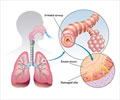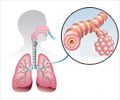FPS-ZM1, an antagonist chemical compound that fights RAGE (the receptor for advanced glycation end-products), may treat COPD.

- Receptor for advanced glycan end-products (RAGE)-specific antagonist chemical compound, FPS-ZM1 has a protective role in COPD.
- Coronary Obstructive Pulmonary Disease //(COPD) is a group of lung conditions which include chronic bronchitis, emphysema and chronic asthma.
- RAGE was associated with the up-regulation of DAMP-related signaling pathways via Nrf2 (a master regulator of the total antioxidant system in humans).
"RAGE disturbances in pulmonary disorders are precise and effective strategies with beneficial clinical effects," said Se-Ran Yang, D.V.M., Ph.D., a researcher involved in the work and an associate professor at the Department of Thoracic and Cardiovascular Surgery in the School of Medicine at Kangwon National University in Gangwon, Korea.
"Blockade of RAGE is a novel clinical therapeutic for COPD ameliorates emphysema/COPD development and progression."
In their study, Yang and colleagues investigated the efficacy of RAGE-specific antagonist FPS-ZM1 administration in both in vivo and in vitro COPD models to determine the molecular mechanism by which RAGE influences COPD.
The researchers injected mice with an in vivo COPD inducer and the RAGE antagonist FPS-ZM1. Then they assessed the infiltrated inflammatory cells and their production of cytokines.
They analyzed downstream damage-associated molecular patterns (DAMPs) and danger signals in vivo and in vitro and in patients with COPD, and found that RAGE was associated with the up-regulation of DAMP-related signaling pathways via Nrf2 (a master regulator of the total antioxidant system in humans). FPS-ZM1 administration also significantly reversed emphysematous lung symptoms in mice.
Reference
- Hanbyeol Lee et al., Blockade of RAGE ameliorates elastase-induced emphysema development and progression via RAGE-DAMP signaling, The FASEB Journal (2017) http://dx.doi.org/10.1096/fj.201601155R.
Source-Medindia















